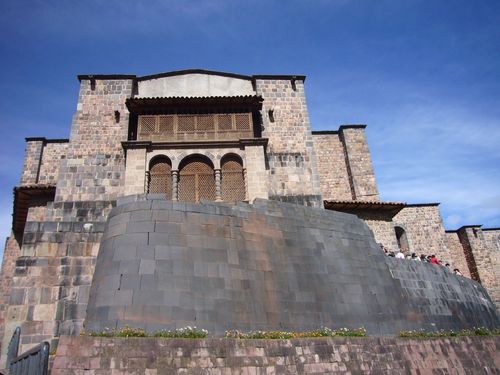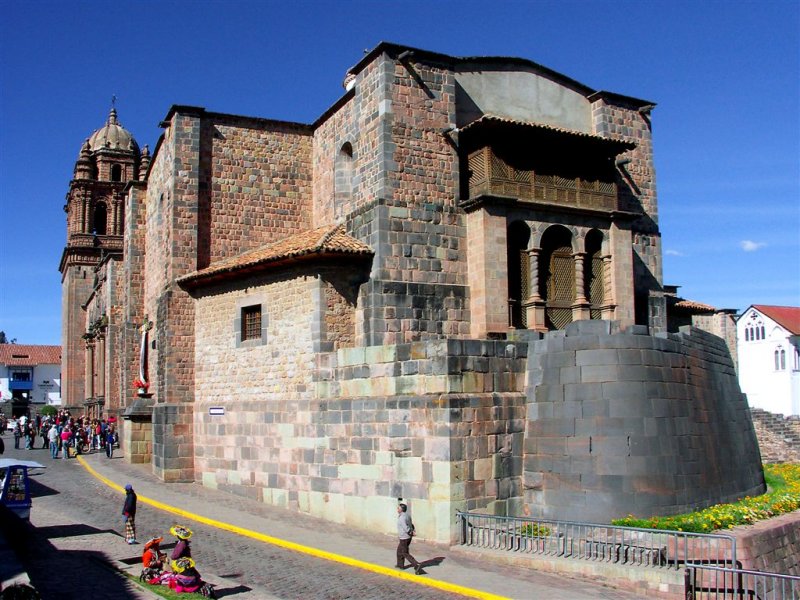The Last Days of the Incas’ Peru Tour #8 (Cusco)
posted on May 29th, 2008 in Cuzco: Information about the former Inca capital, Incas, Peru, The Last Days of the Incas' Peru Tour
Cusco (3-4 Days)
Visiting the Qoricancha, or Inca Temple of the Sun
Two long blocks southeast of Cusco’s Plaza de Armas stands the church of Santo Domingo and below it, the Inca’s most sacred temple, the Qoricancha, or temple of the sun. When the first three Spaniards Pizarro had sent to Cusco arrived, they found the Incas’ sun temple gleaming literally like gold. With Pizarro still holding the Inca emperor Atahualpa hostage in northern Peru, the Inca general in charge of the city, General Quisquis, found himself forced to comply with Atahualpa’s orders to help the three Spaniards loot gold and silver from the capital.
Quoting from Chapter 5 of The Last Days of the Incas:
“What had really caught the trio’s attention, however, from the moment they had looked down upon the capital after crossing the final crest of hills, were certain buildings that seemed to burn as brightly as the sun, as if the buildings themselves had been dipped into a golden fire. After some investigation, they discovered that, sure enough, “These buildings were sheathed on the side where the sun rises with large plates of gold…They said there was so much gold in all the buildings of the city that it was a marvelous thing…[and that] they would have brought much more of it if this would not have detained them longer, because they were alone and over 250 leagues from the other Christians….”
“…And now, sometime in March or April 1533, as the Andes were beginning to transcend into the southern hemisphere’s fall and then into winter, [the Inca] General Quisquis found himself gazing at the three foreign emissaries, seated comfortably on litters born by native porters who stood with downcast eyes before him. The visitors wore strange clothes, the general saw, had hair growing from their faces—so unlike his own smooth-skinned race–and even though their skin had browned under the fierce Andean sun, Quisquis could see patches when they moved that were white in color, hidden beneath their ragged and dirty clothes. The foreigners also each wore a long piece of metal at their waists, which Quisquis no doubt presumed was some kind of mace or club, although they looked quite thin and flimsy. The visitors clearly spoke a barbarian tongue, for they replied in an unintelligible manner when spoken to and understood nothing of the empire’s lingua franca, runasimi, or apparently of any other native language. As such they were nearly impossible to communicate with.
“To our Indian eyes,” wrote the native chronicler, Huamán Poma de Ayala, “the Spaniards looked as if they were shrouded like corpses. Their faces were covered with wool, leaving only the eyes visible, and the caps that they wore resembled little red pots on top of their heads. Sometimes they also decorated their heads with plumes. Their swords appeared very long, since they had to be carried with the points turned in a backward direction. They were all dressed alike and talked together like brothers and ate at the same table. Only one of them [Pizarro] seemed to have powers of command and he had a dark face, white teeth and flashing eyes. He often shouted at the others and they obeyed his orders….”
“…[The Inca general] didn’t like the Christians, although he marveled greatly at them,” wrote the notary, Cristóbal de Mena, “…This [Inca general]…told them not to ask him for much gold and that if they refused to release the chief [Atahualpa], then he himself would go to rescue him.” General Quisquis, no doubt suppressing his own desire to immediately seize and kill the foreigners, was now forced to swallow his pride as he allowed the Spaniards to enter the Inca’s most sacred temple–the Qoricancha, or temple of the sun. Doing so was akin to the mayor of Rome allowing three thieves to enter and sack St. Peter’s Cathedral. Or for devout Muslims to allow non-believers to profane and defile the sacred Ka’ba in Mecca. For the Qoricancha was the holiest temple in the Inca Empire. Not open to the public, it was visited only by specialized priests and by the reclusive temple virgins, or mamacuna. All who entered were required to remove their shoes and to perform numerous forms of religious observances and ablutions.
The two sailors and the notary, oblivious to Inca culture and concerned only with immediate plunder, entered the temple in their shabby leather boots and pushed past the stunned temple priests. They soon discovered that the Qoricancha was lined both inside and out with banded sheets of gold:
“The Christians went to the buildings and with no aid from the Indians (who refused to help, saying that it was a temple of the sun and they would die) the Christians decided to strip the ornaments away…with some copper crowbars. And so they did….”
With native crowbars, much grunting and no doubt planting their boots when necessary against the sacred walls, the three Spaniards began prying off the golden sheets, piling them up outside like so much scrap metal before a group of horrified onlookers and angry priests. “The greater part of this consisted of plates like the boards of a box, three or four palmos (two to two-and-a-half feet) in length,” wrote one chronicler. “They had removed these from the walls of the buildings and they had holes in them as if they had been nailed.” Each plate weighed about four-and-a-half pounds, which meant that every plate in monetary terms was enough to buy a caravel ship with, or was worth the equivalent of nine years’ of wages for either of the two sailors carrying them. Eventually, the Spaniards assembled a pile of some seven hundred golden plates, each rudely ripped from the empire’s holiest of walls.”
Visiting Cusco’s Qoricancha and Santo Domingo Church
Beneath the Spanish church of Santo Domingo can still be seen the fine Inca stonework of the sun temple, some of which originally had sheets of gold affixed to the exterior and bands of solid gold affixed to the walls inside. Although called the “sun temple,” the original building actually housed a number of the Incas’ pantheon of gods—those of the sun, moon, thunder and lightning, the rainbow, the stars, and so on. A “garden” of golden objects—llamas and alpacas and replicas of corn stalks and other plants, once stood below the curved stone walls of the sun temple, all of which were gathered and melted down by the Spaniards. 4,000 priests and female attendants once presided here. This was the spiritual center of the Inca universe, the golden hub of their 3,000-mile-long empire. Inside, one can see some of the original chambers that probably housed the various idols, built of perfectly-cut Inca stones.
The temple was originally given by Francisco Pizarro to his younger brother, Juan. After Juan’s death during the battle above Cusco for Saqsaywaman in 1536, he donated it to the Dominican Church and Juan was buried here (although the location of his remains is presently unknown). When Francisco Pizarro’s ex-partner, Diego de Almagro, captured Gonzalo and Hernando Pizarro, he imprisoned them briefly here. Later, they returned the favor and imprisoned Almagro. Almagro was later executed by garrote within one of the temple’s chambers in 1538 (and is now buried not far away, beneath the Church of La Merced, along with Gonzalo Pizarro). A small site museum lies beneath the garden below the church of Santo Domingo.
(To be continued…)
(Below: The Qoricancha, or Inca Temple of the Sun, protruding from Cusco’s Santo Domingo Church. This was the original center of the Incas’ universe.)


